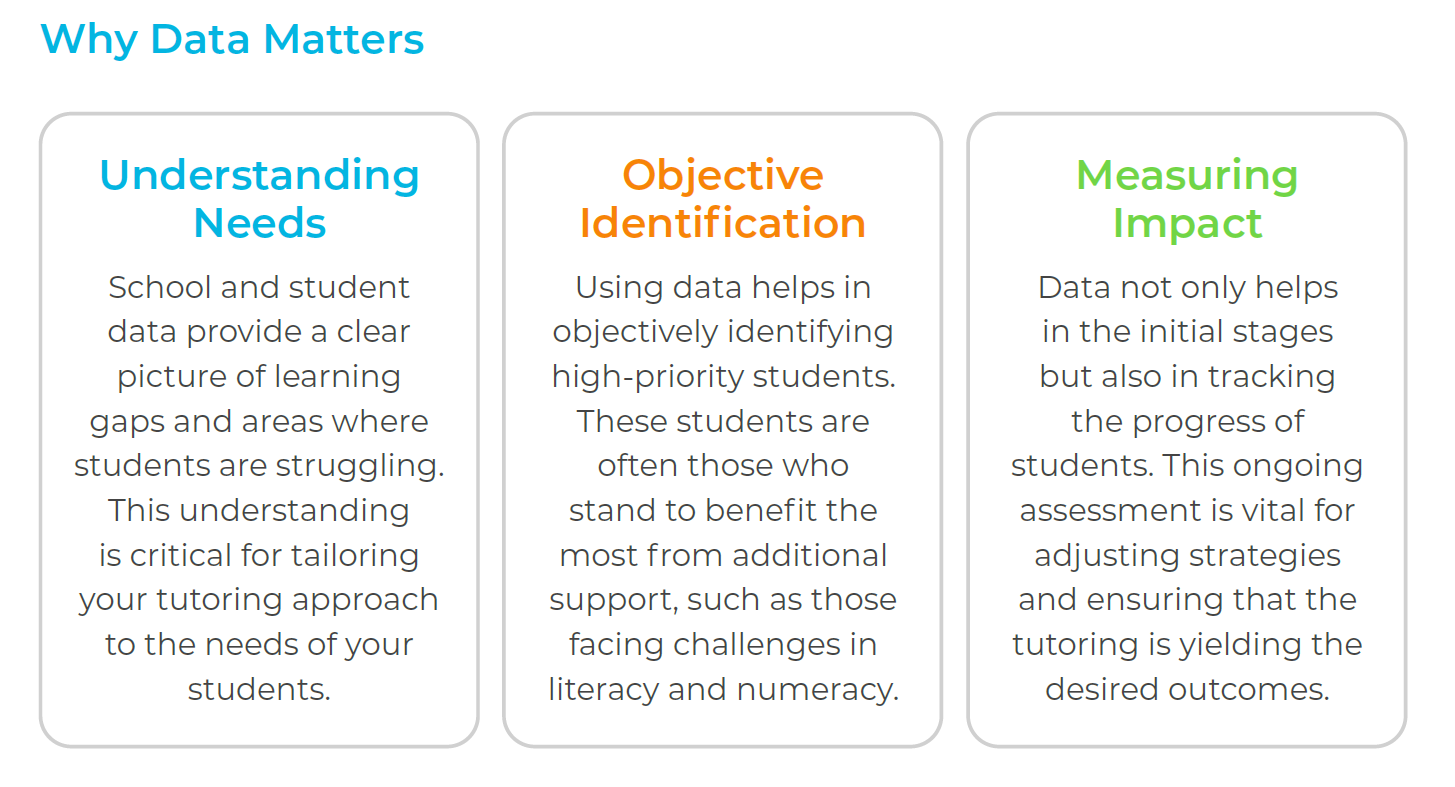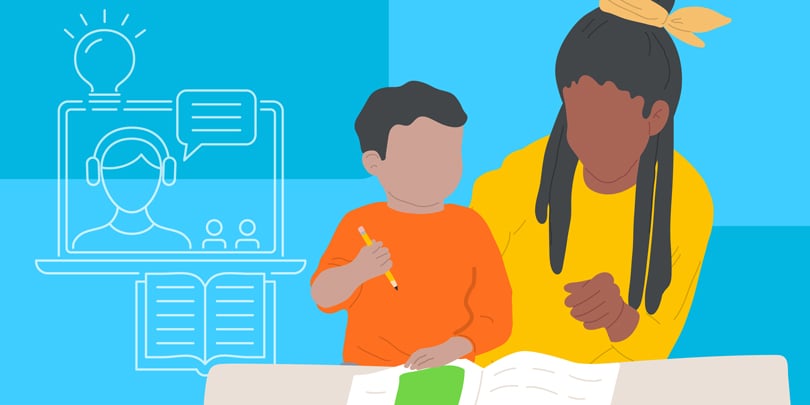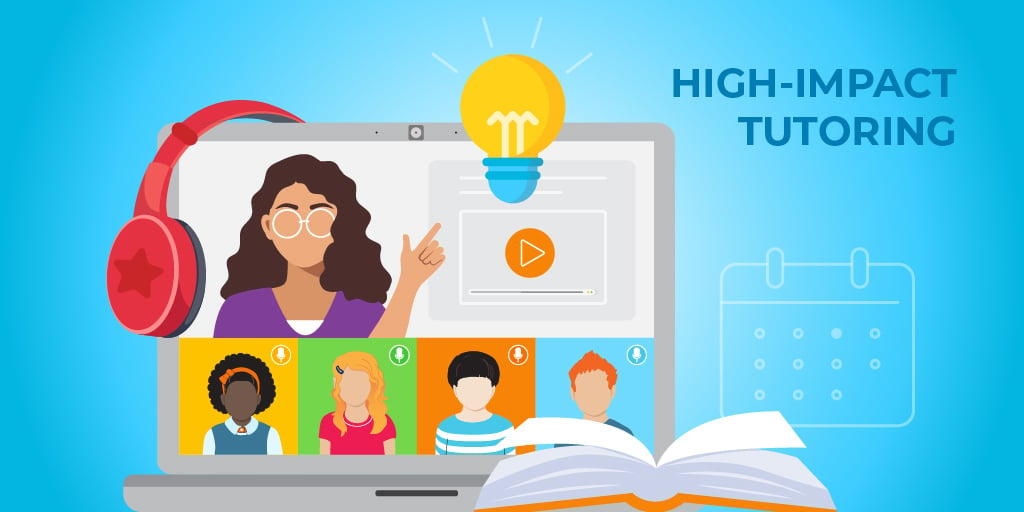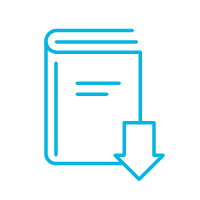The Ultimate Guide to Sucess
- Where should we begin to build a successful initiative?
- How do we use data to uncover the rationale for the initiative?
- How can we support the planning of a strong HIT initiative?
- How do we choose a tutoring program that fits our needs?
- How can we ensure our tutoring initiatives support instruction?
- What ongoing professional development should be offered?
- How can we integrate tutoring sessions into the existing schedule?
Where should we begin to build a successful initiative?
Where to Start? Embarking on a high-impact tutoring initiative begins with a crucial step: diving into data. This step helps you better understand the heartbeat of your student community. Data acts as your compass, guiding every decision and ensuring your efforts directly address your students' specific needs.

Data Types to Consider:
- State Assessments: These provide a broad view of student mastery and are essential starting points for identifying overall learning gaps.
- Local Assessments: Divng into unit and curriculum tests gives a more continuous insight into student performance and specific struggles.
- Learning Standards Analysis: Examining how students perform on individual learning standards across multiple assessments helps identify precise gaps and strengths.
- Microdata: The smaller data points, like formative assessments and anecdotal notes, offer a real-time glimpse into student interactions and comprehension.
When woven together, these diverse data strands create a detailed tapestry of your students' educational needs, laying a solid foundation for a targeted and informed tutoring approach.

At BookNook
We harness data-driven insights to tailor high-impact tutoring that addresses individual learning needs, ensuring every student achieves their full potential.

Get a free copy!
Unlock The Ultimate Guide to Successful High-Impact Tutoring | An excellent resource for your PLCs!
How do we use data to uncover the rationale for the initiative?
To effectively use data in uncovering the rationale for your high-impact tutoring initiative, it's essential to get specific, analyzing various data points to identify underlying issues and areas needing intervention. Here's how to approach this process in a balanced and insightful manner:
Digging Deeper with Data
Embarking on the journey of data analysis means going beyond the surface to understand the 'why' behind the 'what.' It's about piecing together the puzzle of student learning experiences.
Focus on Specific Skills
Begin by pinpointing where students hit roadblocks in their learning. Even the smallest skill gaps can snowball over time, affecting overall academic growth. By identifying these early on, you can tailor your tutoring to tackle these challenges head-on.
Intervention Insights
Take a close look at your existing support structures, such as Tier 1 instruction and Tier 2 and Tier 3 interventions. Monitoring the rate at which students progress out of Tier 2, for example, offers clues about the effectiveness of your strategies, much like gauging the 'drying time' of paint.
Cross-Reference Data Sets
To get the full picture, merge different data streams. Analyze how various elements, including class sizes, teacher experience, and other school-related factors, play into student performance. This broader view helps situate individual student data within the larger educational ecosystem.
Beyond the Classroom
Don't forget to factor in elements like attendance and behavior. Poor attendance might signal disengagement, and behavioral issues could hint at academic frustrations. These indicators add layers to your understanding, allowing you to address not just academic but also emotional and social needs.
The Comprehensive Approach
By examining data from every angle, you uncover the root causes of learning challenges. This meticulous approach ensures your tutoring initiatives are finely tuned to meet the specific needs of your students, fostering meaningful and sustained academic growth.
This nuanced exploration of data utilization in planning high-impact tutoring initiatives underscores the importance of a detailed, holistic analysis to develop targeted, impactful strategies.
Supporting content
Reflect
How can we support the planning of a strong HIT initiative?
A successful HIT program begins with clarity and communication. After leveraging data to define your initiative's rationale, the next step is setting transparent expectations and establishing open lines of communication among all stakeholders involved.
Setting the Stage with Expectations

Cultivating Communication
Effective communication acts as the engine of any HIT initiative, keeping all parts moving in harmony. Here's how to keep everyone in sync:
- Regular Check-ins: Schedule consistent updates from tutors, teachers, and parents to maintain alignment and address any issues promptly.
- Centralized Information Hub: A single platform where essential resources, schedules, and progress reports are accessible, ensuring all stakeholders are well-informed.
- Open Forums: Facilitate discussions among tutors, teachers, parents, and students to share challenges, questions, and successes, building a sense of community and shared purpose.
Implementing Tools for Communication
Leverage digital tools to streamline communication and feedback:
- Digital Dashboards: Platforms like ParentSquare or Remind provide a centralized space for updates and communication.
- Feedback Loops: Tools such as Google Forms or SurveyMonkey allow for the collection of valuable feedback to continuously refine the program.
- Interactive Newsletters: Use platforms like Smore to create engaging updates that keep everyone connected and informed.
The Impact of Effective Communication
Beyond facilitating smooth operations, clear and consistent communication fosters engagement, clarity, and trust among all participants, contributing to the initiative's overall success.
By focusing on well-defined expectations and robust communication strategies, planning for a strong HIT initiative can be both effective and supportive, ensuring everyone is aligned and committed to student success.

At BookNook
We provide robust support tools, including detailed planning resources and multilingual parent communication, to facilitate successful program implementation.
Reflect
collaboration among tutors, students, teachers, and parents?
How do we choose a tutoring program that fits our needs?
Choosing the right tutoring program for your district involves a careful evaluation of different models and approaches, ensuring the chosen program aligns with your educational goals and meets the specific needs of your students. Here are a few tips to help your team make an informed decision:
Evaluating Tutoring Models
- Personalized vs. Group Settings: Decide between one-on-one tutoring for tailored instruction or small-group tutoring to encourage peer interaction and collaborative learning.
- Virtual vs. In-Person: Consider virtual tutoring for its flexibility and broader tutor selection, or opt for in-house tutoring to maintain a traditional and structured learning environment.
- Peer vs. Professional Tutors: Weigh the benefits of peer tutoring against the expertise and experience professional tutors bring.
Synchronous vs. Asynchronous Learning
- Real-Time Engagement: Synchronous learning offers immediate interaction and feedback, fostering a dynamic and engaging learning experience.
- Structured Routine: It provides a predictable schedule, beneficial for students needing routine and direct support.
- Community and Connection: Live sessions can replicate a classroom's social aspects, crucial for building a learning community and supporting mental well-being.
Selecting a Program
- Targeted Needs: Choose a program based on the specific academic challenges and goals identified through your data analysis.
- Evidence-Based: Opt for programs with a solid research foundation, proven instructional strategies, and positive academic outcomes.
- Customization: Ensure the program offers adaptability to cater to individual student needs, allowing for a more personalized learning experience.
- Curricular Alignment: The tutoring program should complement your existing curriculum, reinforcing key concepts and skills.
- Resource Assessment: Consider the practical aspects, such as required materials, technology, and staffing, ensuring the program's feasibility within your district's infrastructure.
Assessing Effectiveness
- Research and Testimonials: Look into studies, evaluations, and firsthand accounts from other districts to understand the program's impact.
- Continuous Evaluation: Implement ongoing monitoring to track the program's effectiveness, making adjustments as needed based on student progress and feedback.
By meticulously comparing different tutoring models, considering synchronous versus asynchronous options, and assessing each program's alignment with your district's goals and resources, you can select a tutoring program that fits your needs and promises meaningful academic growth for your students.

At BookNook
Our tutoring solutions are customizable, offering synchronous, small-group, and one-to-one sessions that align with your district’s specific educational objectives.
Reflect
stand out for your school or district?
How can we ensure our tutoring initiative supports instruction?
To weave a tutoring initiative seamlessly into classroom instruction, anchoring it in foundational principles is key. Here's how to integrate these essential elements with a focus on practicality and accessibility:
Research-Based Curriculum
A solid tutoring program starts with a curriculum grounded in proven research. This means using teaching strategies and materials that have shown real-world success in boosting student learning. It's about making informed choices, ensuring the foundation of your tutoring is as strong as the evidence backing it up.
Alignment with State Standards
Aligning tutoring content with state learning standards is non-negotiable. It guarantees that tutoring efforts complement what's being taught in classrooms, providing students with a consistent and cohesive learning experience. This strategic alignment helps students meet key academic benchmarks, ensuring the tutoring program is an extension of their classroom learning.
Diversity of Texts
Incorporating a wide range of texts is about more than just variety; it's about representation. Selecting materials that reflect diverse cultures and perspectives ensures that all students can see themselves in their learning, fostering a more supportive and engaging educational environment. It's also about challenging students with different viewpoints and narratives, enriching their learning and understanding of the world.
By grounding your tutoring initiative in these principles, you're not just adding extra help; you're enriching the educational ecosystem. It ensures the tutoring is relevant and directly supportive of classroom instruction, making for a well-rounded and impactful learning experience for students.

At BookNook
We complement classroom instruction with a diverse range of reading materials, ensuring that our content is engaging and representative of our students’ experiences.
Supporting content
Reflect
equity, and efficiency of your tutoring initiative?
What ongoing professional development should be offered?
For a tutoring program to thrive, ongoing professional development for tutors is key. Here's a straightforward approach to fostering continuous growth and enhancing the skills of your tutoring team:
The Role of Professional Development
Professional development is essential for keeping tutors up-to-date with the latest teaching methods, research, and educational trends. It helps tutors refine their techniques, deepen their subject knowledge, and better meet students' needs, contributing to the overall quality and success of the tutoring program.
Types of Professional Development
-
Initial Training: Start with comprehensive training for new tutors, covering the program's goals, effective tutoring strategies, engagement techniques, and cultural sensitivity. This foundation is crucial for consistency and quality in tutoring sessions.
-
Workshops and Sessions: Regular workshops focused on specific improvement areas, identified through feedback or data analysis, can help tutors address common challenges, learn new strategies, and stay current with educational practices.
-
External Experts and Online Resources: Incorporating insights from external experts and online learning resources can expose tutors to a broader range of ideas and strategies, enriching their tutoring approach.
-
Focused Objectives: Encourage tutors to set clear objectives for their professional development, making each learning opportunity more targeted and effective.
"Ongoing professional development boosts tutor effectiveness by enhancing skills, keeping pace with educational trends, and meeting students' evolving needs."
Supporting Independent Learning
-
Resource Libraries: A well-curated collection of materials, articles, and resources accessible to tutors can support their self-directed learning and ongoing professional growth.
-
Peer Collaboration: Facilitating forums or meetings where tutors can share experiences and strategies fosters a collaborative learning environment and promotes collective improvement.
-
Reflective Practices: Encourage tutors to reflect on their tutoring sessions, identify areas for growth, and adapt their methods accordingly. This reflective approach can lead to more personalized and effective tutoring strategies.
Fostering a Learning Community
-
Mentorship Programs: Pairing new tutors with experienced mentors can help novices navigate the challenges of tutoring, learn from seasoned tutors, and integrate more smoothly into the tutoring program.
-
Collaborative Learning: Organizing group learning opportunities, like study groups or learning circles, can encourage tutors to explore new topics and strategies together, enhancing their collective expertise.
-
Guest Speakers and Events: Hosting presentations by guest speakers or experts can introduce tutors to new perspectives and research, broadening their understanding of effective tutoring practices.
By emphasizing ongoing professional development through varied formats and opportunities, you can build a tutoring program where continuous learning, collaboration, and improvement are part of the culture, ultimately leading to a more effective and dynamic tutoring initiative.

At BookNook
We prioritize continuous professional development, offering comprehensive training and a thriving learning community to keep our tutors at the forefront of educational best practices.
Supporting content
Reflect
How can we integrate tutoring sessions into the existing schedule?
Integrating tutoring sessions into the existing school schedule requires strategic planning to ensure that it complements rather than disrupts the educational flow. The key lies in creating a seamless blend of tutoring with daily classroom activities, making the tutoring program feel like a natural extension of the learning environment.
Strategies for Integrating Tutoring Sessions into the School Day
One effective approach is to embed tutoring within the school day by designating specific times during class for targeted interventions. This method allows students to receive the additional help they need without feeling singled out or having their day extended unnecessarily. It's about smartly carving out moments within the existing structure, perhaps during a period typically reserved for independent work or group activities, where tutoring can take place right in the classroom.
Offering tutoring outside of traditional school hours, such as before or after school, is another option. While not ideal for every student due to potential scheduling conflicts, this can be a valuable resource for those who can attend. Ensuring that transportation and other logistical issues are addressed is crucial to making this option accessible to all students who need it.
Collaboration with teachers is pivotal in this integration process. Their insights can help identify the best times for tutoring that align with students' needs and the curriculum. This partnership fosters a cohesive approach, where tutoring is a coordinated effort supporting classroom instruction. Teachers can play a significant role in identifying which students might benefit most from additional help and at what times tutoring could be most effective without detracting from essential classroom learning.
In essence, the goal is to weave tutoring into the fabric of the school day in a way that feels both intentional and effortless. By doing so, tutoring becomes a supportive tool that enhances the educational experience without adding unnecessary stress or disruption to students' already busy lives. This thoughtful integration ensures that every student has the opportunity to benefit from additional support, paving the way for a more supportive and effective learning environment.
Optimizing Time Allocation for Tutoring while Ensuring Minimal Disruption
It's also important to consider how time is allocated to ensure minimal disruption and maximum impact. Optimizing time allocation involves a careful balance, ensuring that each tutoring session is long enough to be meaningful but not so long that it significantly encroaches on other essential learning activities.
Allocating time for tutoring requires a data-driven approach, where student performance data inform decisions and needs assessments. This ensures that time dedicated to tutoring is targeted effectively, focusing on students who need the most support while being mindful of the overall school schedule. For instance, longer sessions might be reserved for students who require intensive support, while others may benefit from shorter, more frequent check-ins.
Efficient management of transition times between classes and activities is another critical aspect. Minimizing these transitions can maximize instructional time, allowing for smoother integration of tutoring sessions. The aim is to ensure that students can move seamlessly from regular instruction to tutoring without unnecessary downtime, keeping the day's rhythm intact.
Ultimately, the seamless integration of tutoring within the school day, through thoughtful time allocation and efficient scheduling, ensures that tutoring enriches the learning experience without adding strain to the school's daily operations. This approach not only supports students' academic growth but also respects the integrity of the school day, maintaining a balance between new learning opportunities and ongoing classroom activities.

At BookNook
We collaborate closely with schools to seamlessly integrate tutoring into existing schedules, ensuring minimal disruption and maximal educational benefit.
Supporting content
Reflect
integrating tutoring sessions into the existing school schedule?

Get a free copy!
Unlock The Ultimate Guide to Successful High-Impact Tutoring | An excellent resource for your PLCs!
Author:
From Our Blog
Stay up to date with what is new in our industry, learn more about the upcoming products and events.

How High-Impact Tutoring Strengthens State Assessment Readiness
.jpg)
Why the NSSA Badge Matters More Than It Might Seem


